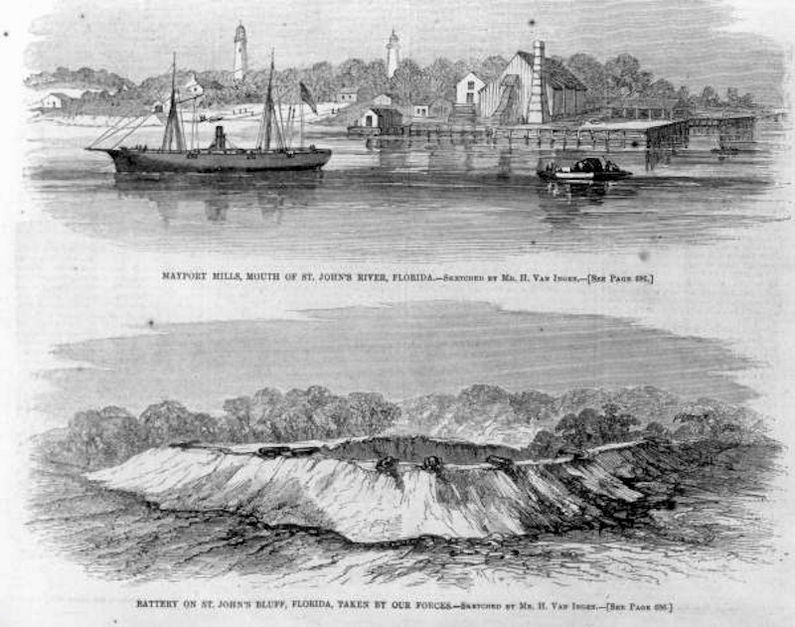St. John's Bluff Confederate Battery
|
St. John's Bluff Confederate Battery (1862-1865) - A Confederate U.S. Civil War Battery established in 1862 on St. John's Bluff, Duval County, Florida. Captured by Union Forces on 3 Oct 1962. Abandoned in 1865 at the end of the war. Also known as St. John's Bluff Fort.
HistorySt. John's bluff is a 60' high bluff located on the St. John's River's approach to Jacksonville. With a clear view of the river all the way to the sea, it was an ideal location for Confederate artillery to control Union gunboats who were stationed at Mayport. At the base of the very steep bluff, St. John's creek ran into the river. Brigadier General Joseph Finegan became the Confederate commander in east Florida in April 1862. With few resources and a handful of troops, he found enough artillery by September 1862 to fortify St. Johns Bluff. The Confederate troops used slave labor to construct an earthworks battery next to the spot where the Rebaut monument is located today. Initially, the battery was armed with six guns, two 32-pounders, two 8" Howitzers, and two 12-pounder rifled guns. The guns were placed in the battery on the 9th of September under the command of Captain Joseph L. Dunham. Late that night, a contraband informed the Captain of a Union gunboat of the now armed battery. The next evening the gunboat fired nine shells into the bluff to feel out the battery but there was no reply, they weren't ready yet. On 11 Sep 1862, the battery was ready and the Confederates fired on the first Union gunboats that came within range. Two Union gunboats returned fire but were unable to silence the battery after firing more than 200 shells. The battery was undamaged in the fight with one person killed. The gunboats fared worse, one was seriously damaged and retired for repairs. On 17 Sep 1862, three additional gunboats joined the effort but even the five Union gunboats were unable to dislodge the battery. General Finegan sent an additional four 8" smoothbore cannons to the battery raising the battery to ten guns. Some 800 Union troops were dispatched from along the South Carolina coast to take the Confederate battery from the land side. These troops arrived at Mayport on 1 Oct 1862. The next day, the Union troops attempted a direct attack but found the creek unfordable and they then began a march towards the rear of the Confederate position. The Confederate commander on the bluff, Colonel Charles F. Hopkins believed that 5,000, not 800, Union troops were preparing to assault his defenses and in the process cut off any escape path. After a unanimous vote of his officers, Colonel Hopkins ordered his men to hastily retreat from the battery at 9 pm on October 2nd. The retreat was ordered so quickly that the guns were not spiked or blown up. Union troops then occupied the battery and captured all the Confederate cannons. All of the guns were removed and sent to Hilton Head and the magazine was blown up. The Confederate retreat from St. Johns Bluff was seen as a humiliating defeat. Union forces reoccupied Jacksonville on 3 Oct 1962, and their gunboats once again ran the river. General Finegan called Colonel Hopkins' retreat a "gross military blunder". Hopkins demanded a court-martial to defend his actions. The court-martial exonerated him because the State had removed the men and material necessary for the defense of St. John's Bluff. Current StatusVery little remains. This site is said to be next to the Ribault Monument site on St. John's Bluff. All that can be seen are some low overgrown earthworks on the right side of the monument site. This is further complicated by indications that the Confederate battery was over-built in 1898 by a temporary Spanish-American War Seige battery intended to guard the mouth of the St. John's River.
See Also:
Links: Visited: 18 Aug 2021
| |||||||
